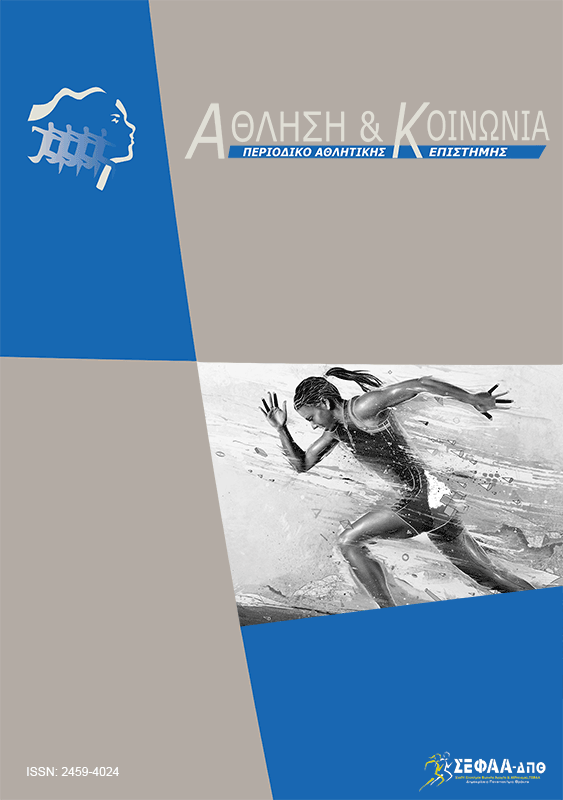Τεχνολογικά συστήματα και εφαρμογές παρακολούθησης της εσωτερικής και εξωτερικής επιβάρυνσης στο ποδόσφαιρο
Λέξεις-κλειδιά:
Προπονητικό φορτίο, εσωτερική επιβάρυνση, εξωτερική επιβάρυνση, Σύνδρομο Γενικής Προσαρμογής, Παγκόσμιο Σύστημα ΘεσιθεσίαςΠερίληψη
Η παρακολούθηση του προπονητικού φορτίου (TL) εφαρμόζεται συνήθως για την αξιολόγηση της φυσικής προσπάθειας που επιτελεί ένας αθλητής κατά την προπόνηση (δηλ. εξωτερικό φορτίο) και της επακόλουθης ανταπόκρισης του αθλητή κατά την προπόνηση (δηλ. εσωτερικό φορτίο). Στόχος της καταγραφής της φυσιολογικής επιβάρυνσης είναι η αξιολόγηση και διαχείριση του συνολικού στρες το οποίο επωμίζεται ο κάθε ποδοσφαιριστής μέσω εσωτερικών και εξωτερικών προκλήσεων κατά τη διάρκεια της προαγωνιστικής και αγωνιστικής περιόδου. Οι πιο πάνω προκλήσεις οδηγούν σε διαταραχή της οργανικής ομοιόστασης μέσω ποικίλων φυσιοβιοχημικών ανταποκρίσεων οι οποίες σε ότι αφορά στην προπονητική και αγωνιστική τους προέλευση επεξηγούνται μέσω του «Συνδρόμου Γενικής Προσαρμογής». Οι εξωτερικές και εσωτερικές επιβαρύνσεις οι οποίες καθορίζουν το επιβαλλόμενο στρες στους ποδοσφαιριστές, προσδιορίζονται μέσω των συστημάτων χωροχρονικού προσδιορισμού θέσης κατά την προπόνηση και τον αγώνα. Η εκτεταμένη χρήση μέσων και μεθόδων καταγραφής της φυσιολογικής επιβάρυνσης στο ποδόσφαιρο αποσκοπεί ουσιαστικά στην εξατομίκευση της προπόνησης τόσο για τη βελτίωση της αγωνιστικής απόδοσης, όσο και για τη μείωση του κινδύνου πρόκλησης τραυματισμών μέσω εστίασης στις πτυχές οι οποίες αφορούν στην αθλητική απόδοση, τη φυσιολογική κατάσταση, το βιοχημικό προφίλ και τη διανοητική οξύτητα. Σε αυτό το πλαίσιο, πέραν των μεθόδων ανάλυσης βιολογικών δειγμάτων, καταγραφής φυσιολογικών δεικτών και της χρήσης επιμέρους ψυχομετρικών εργαλείων και άλλων κλιμάκων, έχει εξελιχθεί σημαντικά και προσαρμοστεί στο ποδόσφαιρο η τεχνολογία του Παγκοσμίου Συστήματος Θεσιθεσίας ή Στιγματοθέτησης (GPS) και η διασύνδεσή της με άλλους μικροηλεκτρομηχανικούς αισθητήρες. Όλα τα παραπάνω επιτρέπουν πολυδιάστατη καταγραφή άμεσων και προκυπτουσών ποσοτήτων οι οποίες αναλύονται στατιστικά για να αποδώσουν άμεση και πλήρη εικόνα της ανταπόκρισης του ποδοσφαιριστή στις προκλήσεις στις οποίες υποβάλλεται.
Αναφορές
Akenhead, R., & Nassis, G. P. (2016). Training load and player monitoring in high-level football: current practice and perceptions. International journal of sports physiology and performance, 11(5), 587-593.
Bourdon, P. C., Cardinale, M., Murray, A., Gastin, P., Kellmann, M., Varley, M. C., ... & Cable, N. T. (2017). Monitoring athlete training loads: consensus statement. International journal of sports physiology and performance, 12(s2), S2-161.
Buchheit, M., & Simpson, B. M. (2017). Player-tracking technology: half-full or half-empty glass?. International journal of sports physiology and performance, 12(s2), S2-35.
Cardinale, M., & Varley, M. C. (2017). Wearable training-monitoring technology: applications, challenges, and opportunities. International journal of sports physiology and performance, 12(s2), S2-55.
Coyle, E. F. (2000). Physical activity as a metabolic stressor. The American journal of clinical nutrition, 72(2), 512S-520S.
Gabbett, T. J. (2010). The development and application of an injury prediction model for noncontact, soft-tissue injuries in elite collision sport athletes. The Journal of Strength & Conditioning Research, 24(10), 2593-2603.
Gabbett, T. J. (2016). The training—injury prevention paradox: should athletes be training smarter and harder?. British journal of sports medicine, 50(5), 273-280.
Gómez-Carmona, C. D., Bastida-Castillo, A., Ibáñez, S. J., & Pino-Ortega, J. (2020). Accelerometry as a method for external workload monitoring in invasion team sports. A systematic review. PloS one, 15(8), e0236643.
Hackney, A. C. (2006). Exercise as a stressor to the human neuroendocrine system. Medicina (Kaunas), 42(10), 788-97.
Hägglund, M., Waldén, M., Magnusson, H., Kristenson, K., Bengtsson, H., & Ekstrand, J. (2013). Injuries affect team performance negatively in professional football: an 11-year follow-up of the UEFA Champions League injury study. British journal of sports medicine, 47(12), 738-742.
Hennessy, L., & Jeffreys, I. (2018). The current use of GPS, its potential, and limitations in soccer. Strength & Conditioning Journal, 40(3), 83-94.
Impellizzeri, F. M., Marcora, S. M., & Coutts, A. J. (2019). Internal and external training load: 15 years on. Int J Sports Physiol Perform, 14(2), 270-273.
Jeffries, A. C., Marcora, S. M., Coutts, A. J., Wallace, L., McCall, A., & Impellizzeri, F. M. (2021). Development of a revised conceptual framework of physical training for use in research and practice. Sports Medicine, 1-16.
Juruena, M. F., Eror, F., Cleare, A. J., & Young, A. H. (2020). The role of early life stress in HPA axis and anxiety. Anxiety disorders: Rethinking and understanding recent discoveries, 141-153.
Malone, J. J., Lovell, R., Varley, M. C., & Coutts, A. J. (2017). Unpacking the black box: applications and considerations for using GPS devices in sport. International journal of sports physiology and performance, 12(s2), S2-18.
Miguel, M., Oliveira, R., Loureiro, N., García-Rubio, J., & Ibáñez, S. J. (2021). Load measures in training/match monitoring in soccer: A systematic review. International Journal of Environmental Research and Public Health, 18(5), 2721.
Pantelopoulos, A., & Bourbakis, N. G. (2009). A survey on wearable sensor-based systems for health monitoring and prognosis. IEEE Transactions on Systems, Man, and Cybernetics, Part C (Applications and Reviews), 40(1), 1-12.
Quarrie, K. L., Raftery, M., Blackie, J., Cook, C. J., Fuller, C. W., Gabbett, T. J., ... & Tucker, R. (2017). Managing player load in professional rugby union: a review of current knowledge and practices. British Journal of Sports Medicine, 51(5), 421-427.
Selye, H. (1946). The general adaptation syndrome and the diseases of adaptation. The journal of clinical endocrinology, 6(2), 117-230.
Selye, H. (1950). Stress and the general adaptation syndrome. British medical journal, 1(4667), 1383.
Seshadri, D. R., Li, R. T., Voos, J. E., Rowbottom, J. R., Alfes, C. M., Zorman, C. A., & Drummond, C. K. (2019). Wearable sensors for monitoring the internal and external workload of the athlete. NPJ digital medicine, 2(1), 71.
Stares, J., Dawson, B., Peeling, P., Heasman, J., Rogalski, B., Drew, M., ... & Lester, L. (2018). Identifying high risk loading conditions for in-season injury in elite Australian football players. Journal of science and medicine in sport, 21(1), 46-51.
Watson, A., Brickson, S., Brooks, A., & Dunn, W. (2017). Subjective well-being and training load predict in-season injury and illness risk in female youth soccer players. British journal of sports medicine, 51(3), 194-199.
Λήψεις
Δημοσιευμένα
Πώς να δημιουργήσετε Αναφορές
Τεύχος
Ενότητα
Άδεια
Οι Συγγραφείς που δημοσιεύουν εργασίες τους σε αυτό το περιοδικό συμφωνούν στους παρακάτω όρους:
α. Οι Συγγραφείς διατηρούν τα Πνευματικά Δικαιώματα και χορηγούν στο περιοδικό το δικαίωμα της πρώτης δημοσίευσης ενώ ταυτόχρονα τα πνευματικά δικαιώματα της εργασίας προστατεύονται σύμφωνα με την Creative Commons Attribution License που επιτρέπει σε τρίτους - αποδέκτες της άδειας να χρησιμοποιούν την εργασία όπως θέλουν με την προϋπόθεση της διατήρησης των διατυπώσεων που προβλέπονται στην άδεια σχετικά με την αναφορά στον αρχικό δημιουργό και την αρχική δημοσίευση σε αυτό το περιοδικό.
β. Οι Συγγραφείς μπορούν να συνάπτουν ξεχωριστές, και πρόσθετες συμβάσεις και συμφωνίες για την μη αποκλειστική διανομή της εργασίας όπως δημοσιεύτηκε στο περιοδικό αυτό (π.χ. κατάθεση σε ένα ακαδημαϊκό καταθετήριο ή δημοσίευση σε ένα βιβλίο), με την προϋπόθεση της αναγνώρισης και την αναφοράς της πρώτης δημοσίευσης σε αυτό το περιοδικό.
γ. Το περιοδικό επιτρέπει και ενθαρρύνει τους Συγγραφείς να καταθέτουν τις εργασίες τους μέσω διαδικτύου (π.χ. σε ένα ακαδημαϊκό καταθετήριο ή στους προσωπικές τους ιστοσελίδες) πριν και μετά από τις διαδικασίες της δημοσίευσης, καθώς αυτό μπορεί να οδηγήσει σε παραγωγική ανταλλαγή ιδεών και σκέψεων καθώς επίσης και σε γρηγορότερη και μεγαλύτερη χρήση και ευρετηρίαση της δημοσιευμένης εργασίας



